List of birds of the Gambia
This is a list of the bird species recorded in the Gambia. The avifauna of the Gambia include a total of 576 species, one of which has been introduced by humans and two of which are globally threatened. The country, which is very small and almost completely surrounded by Senegal, has no endemic species.
The following tags have been used to highlight several categories. Not all species will fall into one of these categories. Those that do not are commonly occurring native species.
- (A) Accidental - a species that rarely or accidentally occurs in the Gambia[1]
- (I) Introduced - a species introduced to the Gambia as a consequence, direct or indirect, of human actions

Grebes
Order: Podicipediformes Family: Podicipedidae
Grebes are small to medium-sized diving birds. They breed on fresh water, but often visit the sea whilst migrating and in winter. They have lobed toes and are excellent swimmers and divers; however, their feet are placed far back on their bodies, making them quite ungainly on land. There are 19 species worldwide. Of these, one species has been recorded in the Gambia.
- Little grebe, Tachybaptus ruficollis
Shearwaters
Order: Procellariiformes Family: Procellariidae
Shearwaters are medium-sized, long-winged seabirds. Highly pelagic, they come ashore only to breed, nesting on islands and rocky cliffs. They generally glide low above the water on stiff wings, and feed on fish, squid and similar oceanic food. There are 23–27 species worldwide. (Some experts split Audubon's shearwater into several distinct species, while others consider those distinctive forms to be subspecies.)
- Manx shearwater, Puffinus puffinus (A)
- Barolo shearwater, Puffinus baroli (A)
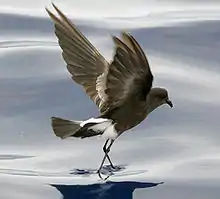
Austral storm petrels
Order: Procellariiformes Family: Oceanitidae
The austral storm petrels are relatives of the petrels and are the smallest seabirds. They feed on planktonic crustaceans and small fish picked from the surface, typically while hovering. The flight is fluttering and sometimes bat-like.
- Wilson's storm petrel, Oceanites oceanicus
Northern storm petrels
Order: Procellariiformes Family: Hydrobatidae
- European storm petrel, Hydrobates pelagicus
- Leach's storm petrel, Oceanodroma leucorhoa (A)
Tropicbirds

Order: Phaethontiformes Family: Phaethontidae
Tropicbirds are slender white birds of tropical oceans, with exceptionally long central tail feathers. Their heads and long wings have black markings.
- Red-billed tropicbird, Phaethon aethereus (A)

Gannets and boobies
Order: Suliformes Family: Sulidae
Gannets and boobies are large seabirds with long beaks and long, pointed wings. They eat fish, which they hunt by plunge-diving from heights of up to 30 m and chasing their prey underwater. They nest colonially on islands and along coasts, either on the ground or in trees.
- Northern gannet, Morus bassanus
- Brown booby, Sula leucogaster (A)
Cormorants
Order: Suliformes Family: Phalacrocoracidae
Cormorants are medium to large seabirds, found primarily along the coast, but occasionally ranging some way inland in aquatic environments. Their plumage is generally dark, though most species have areas of brightly coloured skin on the face. They are primarily fish eaters. Their bills are long, thin and sharply hooked, and their four-toed feet are webbed. Because their plumage is only semi-waterproof, they often stand out of the water with their wings outstretched to dry out their feathers.
- Great cormorant, Phalacrocorax carbo
- Long-tailed cormorant, Microcarbo africanus
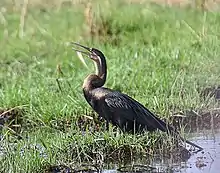
Darters
Order: Suliformes Family: Anhingidae
Darters are large waterbirds, found primarily in fresh and brackish water habitats. Because their plumage is not entirely waterproof, they often stand out of the water with their wings outstretched, drying off. Darters are strongly sexually dimorphic; males generally have much darker plumage than do females. They eat primarily fish, which they catch by diving from the water's surface.
- African darter, Anhinga rufa
Frigatebirds
Order: Suliformes Family: Fregatidae
Frigatebirds are large seabirds typically found soaring over tropical oceans. They have long wings and a deeply forked tail; their plumage is either black (males) or black-and-white (females and young). Males have coloured inflatable throat pouches, which are used in courtship. Frigatebirds spend most of their time in the air. They are kleptoparasites and often chase other seabirds to get them to drop their catches of fish; they also scoop fish from the water's surface.
- Magnificent frigatebird, Fregata magnificens (A)
Pelicans
Order: Pelecaniformes Family: Pelecanidae
Pelicans are large water birds with a distinctive pouch under their beak. As with other members of the order Pelecaniformes, they have webbed feet with four toes.
- Great white pelican, Pelecanus onocrotalus
- Pink-backed pelican, Pelecanus rufescens
Herons, egrets, and bitterns

_dark_morph.jpg.webp)
Order: Pelecaniformes Family: Ardeidae
Herons, egrets and bitterns are long-legged birds typically associated with wetlands; herons and egrets are long-necked, while bitterns tend to be shorter-necked and quite secretive. Birds in this family often wade in shallow waters, preying on various aquatic organisms (including fish and frogs) as well as reptiles, amphibians and the occasional small bird. In flight, they hold their neck retracted in a gentle S-curve.
- Gray heron, Ardea cinerea
- Black-headed heron, Ardea melanocephala
- Goliath heron, Ardea goliath
- Purple heron, Ardea purpurea
- Great egret, Ardea alba
- Intermediate egret, Ardea intermedia
- Black heron, Egretta ardesiaca
- Western reef-heron, Egretta gularis
- Little egret, Egretta garzetta
- Squacco heron, Ardeola ralloides
- Cattle egret, Bubulcus ibis
- Striated heron, Butorides striata
- Black-crowned night-heron, Nycticorax nycticorax
- White-backed night-heron, Gorsachius leuconotus
- White-crested bittern, Tigriornis leucolophus
- Little bittern, Ixobrychus minutus
- Dwarf bittern, Ixobrychus sturmii
- Great bittern, Botaurus stellaris (A)

Hamerkop
Order: Pelecaniformes Family: Scopidae
Hamerkops are medium-sized, all-brown wading birds named for their hammer-headed appearance, which is created by the combination of their shaggy backwards-pointing crests and their heavy black bills. Typically found in wetland areas, they forage in shallow water for amphibians, small fish, crustaceans, insects, worms and small mammals. They build enormous, complex nests—which they generally use for only a matter of months—and occupy their territories year-round.
- Hamerkop, Scopus umbretta
Ibises and spoonbills
Order: Pelecaniformes Family: Threskiornithidae
- Sacred ibis, Threskiornis aethiopicus
- Hadada ibis, Bostrychia hagedash
- Glossy ibis, Plegadis falcinellus
- Eurasian spoonbill, Platalea leucorodia
- African spoonbill, Platalea alba
Storks

Order: Ciconiiformes Family: Ciconiidae
Storks are large, long-legged, long-necked wading birds with long stout bills. They occur in most of the world's warmer regions and tend to live in drier habitats than herons, to which they're closely related. They build large stick nests and sometimes nest colonially. Many species are migratory. Most storks eat a variety of small vertebrates and invertebrates; some eat carrion. Seven species have been recorded in the Gambia.
- Yellow-billed stork, Mycteria ibis
- Black stork, Ciconia nigra (A)
- Abdim's stork, Ciconia abdimii (A)
- Woolly-necked stork, Ciconia episcopus
- White stork, Ciconia ciconia (A)
- Saddle-billed stork, Ephippiorhynchus senegalensis
- Marabou stork, Leptoptilos crumenifer
Flamingos
Order: Phoenicopteriformes Family: Phoenicopteridae
- Greater flamingo, Phoenicopterus roseus
- Lesser flamingo, Phoenicopterus minor Near-threatened
Ducks and geese

Order: Anseriformes Family: Anatidae
- Fulvous whistling duck, Dendrocygna bicolor
- White-faced whistling duck, Dendrocygna viduata
- Egyptian goose, Alopochen aegyptiacus
- Spur-winged goose, Plectropterus gambensis
- Knob-billed duck, Sarkidiornis melanotos
- African pygmy goose, Nettapus auritus
- Green-winged teal, Anas crecca
- Northern pintail, Anas acuta
- Garganey, Spatula querquedula
- Northern shoveler, Spatula clypeata
- Common pochard, Aythya ferina
- Ferruginous duck, Aythya nyroca (A) Near-threatened
- Tufted duck, Aythya fuligula (A)
Hawks, eagles, and kites


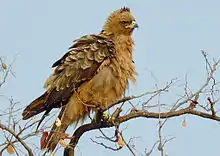
Order: Accipitriformes Family: Accipitridae
- African cuckoo-hawk, Aviceda cuculoides
- European honey-buzzard, Pernis apivorus
- Bat hawk, Macheiramphus alcinus (A)
- Black-winged kite, Elanus caeruleus
- Scissor-tailed kite, Chelictinia riocourii
- Red kite, Milvus milvus (A)
- Black kite, Milvus migrans
- African fish-eagle, Haliaeetus vocifer
- Palm-nut vulture, Gypohierax angolensis
- Hooded vulture, Necrosyrtes monachus
- Egyptian vulture, Neophron percnopterus
- White-backed vulture, Gyps africanus
- Rüppell's griffon, Gyps rueppelli
- Eurasian griffon, Gyps fulvus
- Lappet-faced vulture, Torgos tracheliotos Vulnerable
- White-headed vulture, Trigonoceps occipitalis
- Cinereous vulture, Aegypius monachus (A)
- Short-toed snake-eagle, Circaetus gallicus
- Beaudouin's snake-eagle, Circaetus beaudouini
- Brown snake-eagle, Circaetus cinereus
- Banded snake-eagle, Circaetus cinerascens
- Bateleur, Terathopius ecaudatus
- Eurasian marsh-harrier, Circus aeruginosus
- Pallid harrier, Circus macrourus Near-threatened
- Montagu's harrier, Circus pygargus
- African harrier-hawk, Polyboroides typus
- Lizard buzzard, Kaupifalco monogrammicus
- Dark chanting-goshawk, Melierax metabates
- Gabar goshawk, Micronisus gabar
- Red-chested goshawk, Accipiter toussenelii
- Shikra, Accipiter badius
- Red-thighed sparrowhawk, Accipiter erythropus
- Ovambo sparrowhawk, Accipiter ovampensis
- Eurasian sparrowhawk, Accipiter nisus (A)
- Black goshawk, Accipiter melanoleucus (A)
- Grasshopper buzzard, Butastur rufipennis
- Common buzzard, Buteo buteo (A)
- Long-legged buzzard, Buteo rufinus (A)
- Red-necked buzzard, Buteo auguralis
- Augur buzzard, Buteo augur
- Tawny eagle, Aquila rapax
- Bonelli's eagle, Aquila fasciata (A)
- African hawk-eagle, Aquila spilogaster
- Booted eagle, Hieraaetus pennatus
- Wahlberg's eagle, Hieraaetus wahlbergi
- Ayres's hawk-eagle, Hieraaetus ayresii (A)
- Martial eagle, Polemaetus bellicosus
- Long-crested eagle, Lophaetus occipitalis
- Crowned eagle, Stephanoaetus coronatus (A)
Secretarybird
Order: Accipitriformes Family: Sagittariidae
- Secretarybird, Sagittarius serpentarius (A)
Falcons
Order: Falconiformes Family: Falconidae
- Lesser kestrel, Falco naumanni Vulnerable
- Common kestrel, Falco tinnunculus
- Fox kestrel, Falco alopex (A)
- Grey kestrel, Falco ardosiaceus
- Red-necked falcon, Falco chicquera
- Red-footed falcon, Falco vespertinus (A)[5]
- Eurasian hobby, Falco subbuteo
- African hobby, Falco cuvierii
- Lanner falcon, Falco biarmicus
- Barbary falcon, Falco pelegrinoides
- Peregrine falcon, Falco peregrinus
Pheasants, grouse, and allies
Order: Galliformes Family: Phasianidae
- Common quail, Coturnix coturnix (A)
- White-throated francolin, Peliperdix albogularis
- Ahanta francolin, Pternistis ahantensis
- Double-spurred francolin, Pternistis bicalcaratus
Guineafowl
Order: Galliformes Family: Numididae
- Helmeted guineafowl, Numida meleagris
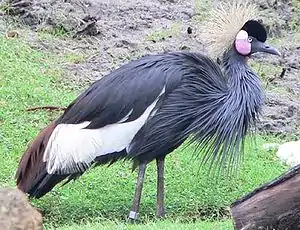
Rails, gallinules and coots
Order: Gruiformes Family: Rallidae
- African crake, Crex egregia
- African rail, Rallus caerulescens (A)
- Black crake, Zapornia flavirostris
- Little crake, Zapornia parva (A)[6]
- Baillon's crake, Zapornia pusilla
- African swamphen, Porphyrio madagascariensis
- Allen's gallinule, Porphyrio alleni (A)
- Eurasian moorhen, Gallinula chloropus
- Lesser moorhen, Paragallinula angulata
- Eurasian coot, Fulica atra (A)
Bustards
Order: Otidiformes Family: Otidae
- Arabian bustard, Ardeotis arabs (A)
- Denham's bustard, Neotis denhami (A) Near-threatened
- White-bellied bustard, Eupodotis senegalensis (A)
- Savile's bustard, Lophotis savilei (A)
- Black-bellied bustard, Lissotis melanogaster
Buttonquail
Order: Charadriiformes Family: Turnicidae
- Small buttonquail, Turnix sylvatica
- Quail-plover, Ortyxelos meiffrenii (A)
Jacanas
Order: Charadriiformes Family: Jacanidae
- African jacana, Actophilornis africanus
_I2_IMG_9477.jpg.webp)
Painted-snipes
Order: Charadriiformes Family: Rostratulidae
- Greater painted-snipe, Rostratula benghalensis
Oystercatchers
Order: Charadriiformes Family: Haematopodidae
- Eurasian oystercatcher, Haematopus ostralegus
Stilts and avocets
Order: Charadriiformes Family: Recurvirostridae
- Black-winged stilt, Himantopus himantopus
- Pied avocet, Recurvirostra avosetta
Thick-knees
Order: Charadriiformes Family: Burhinidae
- Senegal thick-knee, Burhinus senegalensis
- Spotted thick-knee, Burhinus capensis
Egyptian plover
Order: Charadriiformes Family: Pluvianidae
The Egyptian plover is found across equatorial Africa and along the Nile River.
- Egyptian plover, Pluvianus aegyptius
Coursers
Order: Charadriiformes Family: Glareolidae
- Cream-coloured courser, Cursorius cursor (A)
- Temminck's courser, Cursorius temminckii
- Bronze-winged courser, Rhinoptilus chalcopterus
- Collared pratincole, Glareola pratincola
Plovers and lapwings
_Gambia.jpg.webp)
Order: Charadriiformes Family: Charadriidae
Lapwings, plovers and dotterels are small to medium-sized birds with compact bodies, short, thick necks and long, usually pointed, wings. They are found in open country worldwide, generally in habitats near water, although there are some exceptions.
- Northern lapwing, Vanellus vanellus (A)
- Senegal lapwing, Vanellus lugubris (A)
- Spur-winged lapwing, Vanellus spinosus
- Black-headed lapwing, Vanellus tectus
- White-headed lapwing, Vanellus albiceps
- Wattled lapwing, Vanellus senegallus
- American golden-plover, Pluvialis dominica (A)
- European golden-plover, Pluvialis apricaria
- Black-bellied plover, Pluvialis squatarola
- Common ringed plover, Charadrius hiaticula
- Little ringed plover, Charadrius dubius
- Kittlitz's plover, Charadrius pecuarius
- Forbes's plover, Charadrius forbesi (A)[7]
- White-fronted plover, Charadrius marginatus
- Caspian plover, Charadrius asiaticus (A)
- Kentish plover, Charadrius alexandrinus
- Eurasian dotterel, Charadrius morinellus (A)
Sandpipers and allies
_at_Bharatpur_I_IMG_5501.jpg.webp)
.jpg.webp)

Order: Charadriiformes Family: Scolopacidae
- Jack snipe, Lymnocryptes minimus
- Great snipe, Gallinago media Near-threatened
- Common snipe, Gallinago gallinago
- Black-tailed godwit, Limosa limosa
- Bar-tailed godwit, Limosa lapponica
- Whimbrel, Numenius phaeopus
- Eurasian curlew, Numenius arquata
- Spotted redshank, Tringa erythropus
- Common redshank, Tringa totanus
- Marsh sandpiper, Tringa stagnatilis
- Common greenshank, Tringa nebularia
- Lesser yellowlegs, Tringa flavipes (A)
- Green sandpiper, Tringa ochropus
- Solitary sandpiper, Tringa solitaria (A)[8]
- Wood sandpiper, Tringa glareola
- Terek sandpiper, Xenus cinereus (A)
- Common sandpiper, Actitis hypoleucos
- Ruddy turnstone, Arenaria interpres
- Red knot, Calidris canutus
- Sanderling, Calidris alba
- Little stint, Calidris minuta
- Temminck's stint, Calidris temminckii
- Baird's sandpiper, Calidris bairdii (A)
- Curlew sandpiper, Calidris ferruginea
- Dunlin, Calidris alpina
- Purple sandpiper, Calidris maritima
- Ruff, Calidris pugnax
- Red-necked phalarope, Phalaropus lobatus
- Grey phalarope, Phalaropus fulicarius
Skuas
Order: Charadriiformes Family: Stercorariidae
- Pomarine skua, Stercorarius pomarinus
- Arctic skua, Stercorarius parasiticus
Gulls, terns, and skimmers

Order: Charadriiformes Family: Laridae
- Audouin's gull, Ichthyaetus audouinii Near-threatened
- Mediterranean gull, Ichthyaetus melanocephalus (A)
- Common gull, Larus canus (A)
- Kelp gull, Larus dominicanus
- Lesser black-backed gull, Larus fuscus
- Yellow-legged gull, Larus michahellis
- Grey-headed gull, Chroicocephalus cirrocephalus
- Black-headed gull, Chroicocephalus ridibundus
- Slender-billed gull, Chroicocephalus genei
- Laughing gull, Leucophaeus atricilla (A)
- Franklin's gull, Leucophaeus pipixcan (A)
- Little gull, Hydrocoloeus minutus (A)
- Black-legged kittiwake, Rissa tridactyla (A)
- Gull-billed tern, Gelochelidon nilotica
- Caspian tern, Hydroprogne caspia
- Lesser crested tern, Thalasseus bengalensis
- Sandwich tern, Thalasseus sandvicensis
- Royal tern, Thalasseus maximus
- Roseate tern, Sterna dougallii (A)
- Common tern, Sterna hirundo
- Arctic tern, Sterna paradisaea
- Little tern, Sternula albifrons
- Whiskered tern, Chlidonias hybrida
- White-winged tern, Chlidonias leucopterus
- Black tern, Chlidonias niger
- Bridled tern, Onychoprion anaethetus (A)[9]
- Black noddy, Anous minutus (A)
- Brown noddy, Anous stolidus (A)
- African skimmer, Rynchops flavirostris Near-threatened
Sandgrouse
Order: Pterocliformes Family: Pteroclidae
- Chestnut-bellied sandgrouse, Pterocles exustus (A)
- Four-banded sandgrouse, Pterocles quadricinctus
Doves and pigeons
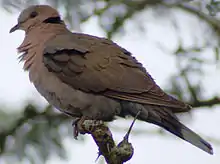
Order: Columbiformes Family: Columbidae
- Rock dove, Columba livia
- Speckled pigeon, Columba guinea
- Eurasian turtle dove, Streptopelia turtur
- Adamawa turtle dove, Streptopelia hypopyrrha
- African collared dove, Streptopelia roseogrisea
- Mourning collared dove, Streptopelia decipiens
- Red-eyed dove, Streptopelia semitorquata
- Vinaceous dove, Streptopelia vinacea
- Laughing dove, Spilopelia senegalensis
- Black-billed wood dove, Turtur abyssinicus
- Blue-spotted wood dove, Turtur afer
- Namaqua dove, Oena capensis
- Bruce's green pigeon, Treron waalia
- African green pigeon, Treron calva
Old World parrots
Order: Psittaciformes Family: Psittaculidae
- Rose-ringed parakeet, Psittacula krameri
African and New World parrots

Order: Psittaciformes Family: Psittacidae
- Grey-headed parrot, Poicephalus robustus
- Senegal parrot, Poicephalus senegalus
Turacos
Order: Musophagiformes Family: Musophagidae
- Guinea turaco, Tauraco persa
- Violet turaco, Musophaga violacea
- Western grey plantain-eater, Crinifer piscator
Cuckoos
.jpg.webp)
Order: Cuculiformes Family: Cuculidae
- Pied cuckoo, Clamator jacobinus
- Levaillant's cuckoo, Clamator levaillantii
- Great spotted cuckoo, Clamator glandarius
- Red-chested cuckoo, Cuculus solitarius
- Black cuckoo, Cuculus clamosus (A)
- Common cuckoo, Cuculus canorus
- African cuckoo, Cuculus gularis
- Klaas's cuckoo, Chrysococcyx klaas
- African emerald cuckoo, Chrysococcyx cupreus (A)
- Dideric cuckoo, Chrysococcyx caprius
- Blue malkoha, Ceuthmochares aereus
- Black coucal, Centropus grillii
- Senegal coucal, Centropus senegalensis
True owls

Order: Strigiformes Family: Strigidae
- African scops owl, Otus senegalensis
- Eurasian scops owl, Otus scops
- White-faced scops owl, Ptilopsis leucotis
- Greyish eagle-owl, Bubo cinerascens
- Verreaux's eagle-owl, Bubo lacteus
- Pel's fishing owl, Scotopelia peli
- African wood owl, Strix woodfordii
- Pearl-spotted owlet, Glaucidium perlatum
- Marsh owl, Asio capensis
Nightjars
_male.jpg.webp)
Order: Caprimulgiformes Family: Caprimulgidae
- Red-necked nightjar, Caprimulgus ruficollis
- European nightjar, Caprimulgus europaeus
- Swamp nightjar, Caprimulgus natalensis (A)
- Plain nightjar, Caprimulgus inornatus
- Long-tailed nightjar, Caprimulgus climacurus
- Pennant-winged nightjar, Caprimulgus vexillarius (A)
- Standard-winged nightjar, Caprimulgus longipennis
Swifts
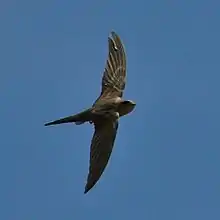
Order: Caprimulgiformes Family: Apodidae
- Mottled spinetail, Telacanthura ussheri
- African palm-swift, Cypsiurus parvus
- Alpine swift, Apus melba
- Common swift, Apus apus
- Pallid swift, Apus pallidus
- Little swift, Apus affinis
- White-rumped swift, Apus caffer
Kingfishers

Order: Coraciiformes Family: Alcedinidae
- Shining blue kingfisher, Alcedo quadribrachys
- Malachite kingfisher, Corythornis cristatus
- African pygmy kingfisher, Ispidina picta
- Grey-headed kingfisher, Halcyon leucocephala
- Woodland kingfisher, Halcyon senegalensis
- Blue-breasted kingfisher, Halcyon malimbica
- Striped kingfisher, Halcyon chelicuti
- Giant kingfisher, Megaceryle maxima
- Pied kingfisher, Ceryle rudis
Bee-eaters
.jpg.webp)
Order: Coraciiformes Family: Meropidae
- Red-throated bee-eater, Merops bulocki
- Little bee-eater, Merops pusillus
- Swallow-tailed bee-eater, Merops hirundineus
- White-throated bee-eater, Merops albicollis
- Little green bee-eater, Merops orientalis
- Blue-cheeked bee-eater, Merops persicus
- European bee-eater, Merops apiaster
- Northern carmine bee-eater, Merops nubicus
Rollers
Order: Coraciiformes Family: Coraciidae
- European roller, Coracias garrulus
- Abyssinian roller, Coracias abyssinica
- Rufous-crowned roller, Coracias naevia
- Blue-bellied roller, Coracias cyanogaster
- Broad-billed roller, Eurystomus glaucurus
Woodhoopoes
Order: Bucerotiformes Family: Phoeniculidae
- Green woodhoopoe, Phoeniculus purpureus
- Black woodhoopoe, Rhinopomastus aterrimus
Hornbills
Order: Bucerotiformes Family: Bucerotidae
- Western red-billed hornbill, Tockus kempi
- African pied hornbill, Lophoceros fasciatus
- African grey hornbill, Lophoceros nasutus
Ground-hornbills
Order: Bucerotiformes Family: Bucorvidae
The ground-hornbills are terrestrial birds which feed almost entirely on insects, other birds, snakes, and amphibians.
- Abyssinian ground-hornbill, Bucorvus abyssinicus
Tinkerbirds
Order: Piciformes Family: Lybiidae
- Yellow-rumped tinkerbird, Pogoniulus bilineatus
- Yellow-fronted tinkerbird, Pogoniulus chrysoconus
- Vieillot's barbet, Lybius vieilloti
- Bearded barbet, Lybius dubius
Honeyguides
Order: Piciformes Family: Indicatoridae
- Spotted honeyguide, Indicator maculatus
- Greater honeyguide, Indicator indicator
- Lesser honeyguide, Indicator minor
Woodpeckers
Order: Piciformes Family: Picidae
- Eurasian wryneck, Jynx torquilla
- Fine-spotted woodpecker, Campethera punctuligera
- Golden-tailed woodpecker, Campethera abingoni
- Buff-spotted woodpecker, Campethera nivosa
- Little grey woodpecker, Chloropicus elachus (A)
- Cardinal woodpecker, Chloropicus fuscescens
- African grey woodpecker, Chloropicus goertae
- Brown-backed woodpecker, Chloropicus obsoletus
Larks
Order: Passeriformes Family: Alaudidae
- Singing bushlark, Mirafra cantillans
- Flappet lark, Mirafra rufocinnamomea
- Rufous-rumped lark, Pinarocorys erythropygia (A)
- Greater short-toed lark, Calandrella brachydactyla (A)
- Chestnut-backed sparrow-lark, Eremopterix leucotis
- Crested lark, Galerida cristata
- Sun lark, Galerida modesta
- Temminck's horned lark, Eremophila bilopha (A)[10]
Nicators
Order: Passeriformes Family: Nicatoridae
The nicators are shrike-like, with hooked bills. They are endemic to sub-Saharan Africa.
- Western nicator, Nicator chloris (A)
Swallows
Order: Passeriformes Family: Hirundinidae
- Bank swallow, Riparia riparia
- Plain martin, Riparia paludicola
- Banded martin, Riparia cincta (A)
- Eurasian crag-martin, Ptyonoprogne rupestris
- Gray-rumped swallow, Hirundo griseopyga (A)
- Barn swallow, Hirundo rustica
- Red-chested swallow, Hirundo lucida
- Ethiopian swallow, Hirundo aethiopica
- Wire-tailed swallow, Hirundo smithii
- Pied-winged swallow, Hirundo leucosoma
- Lesser striped swallow, Cecropis abyssinica (A)
- Rufous-chested swallow, Cecropis semirufa
- Mosque swallow, Cecropis senegalensis
- Red-rumped swallow, Cecropis daurica
- Common house-martin, Delichon urbicum
- Fanti sawwing, Psalidoprocne obscura
Wagtails and pipits
Order: Passeriformes Family: Motacillidae
- White wagtail, Motacilla alba
- African pied wagtail, Motacilla aguimp (A)
- Western yellow wagtail, Motacilla flava
- Yellow-throated longclaw, Macronyx croceus
- Plain-backed pipit, Anthus leucophrys
- Tawny pipit, Anthus campestris
- Tree pipit, Anthus trivialis
- Red-throated pipit, Anthus cervinus
Cuckooshrikes
Order: Passeriformes Family: Campephagidae
- White-breasted cuckooshrike, Coracina pectoralis
- Red-shouldered cuckooshrike, Campephaga phoenicea
Bulbuls
Order: Passeriformes Family: Pycnonotidae
- Common bulbul, Pycnonotus barbatus
- Little greenbul, Eurillas virens
- Sjöstedt's greenbul, Baeopogon clamans
- Yellow-throated greenbul, Atimastillas flavicollis
- Swamp greenbul, Thescelocichla leucopleura (A)
- Leaf-love, Phyllastrephus scandens
- White-throated greenbul, Phyllastrephus albigularis
- Gray-headed bristlebill, Bleda canicapillus
- Red-tailed greenbul, Criniger calurus
Cisticolas
Order: Passeriformes Family: Cisticolidae
- Red-faced cisticola, Cisticola erythrops
- Singing cisticola, Cisticola cantans
- Whistling cisticola, Cisticola lateralis
- Dorst's cisticola, Cisticola guinea
- Winding cisticola, Cisticola marginatus
- Croaking cisticola, Cisticola natalensis
- Siffling cisticola, Cisticola brachypterus
- Rufous cisticola, Cisticola rufus
- Zitting cisticola, Cisticola juncidis
- Desert cisticola, Cisticola aridulus
- Black-backed cisticola, Cisticola eximius
- Tawny-flanked prinia, Prinia subflava
- River prinia, Prinia fluviatilis (A)[11]
- Red-winged prinia, Prinia erythroptera
- Yellow-breasted apalis, Apalis flavida
- Oriole warbler, Hypergerus atriceps
- Grey-backed camaroptera, Camaroptera brachyura
- Olive-green camaroptera, Camaroptera chloronota (A)
- Senegal eremomela, Eremomela pusilla
- Green-backed eremomela, Eremomela canescens
African warblers
Order: Passeriformes Family: Macrosphenidae
- African moustached warbler, Melocichla mentalis (A)
- Green crombec, Sylvietta virens
- Lemon-bellied crombec, Sylvietta denti (A)
- Northern crombec, Sylvietta brachyura
- Green hylia, Hylia prasina
Locustellid warblers
Order: Passeriformes Family: Locustellidae
- Common grasshopper warbler, Locustella naevia (A)
Acrocephalid warblers
.jpg.webp)
Order: Passeriformes Family: Acrocephalidae
- Sedge warbler, Acrocephalus schoenobaenus
- Eurasian reed warbler, Acrocephalus scirpaceus
- African reed warbler, Acrocephalus baeticatus
- Great reed warbler, Acrocephalus arundinaceus (A)
- Greater swamp warbler, Acrocephalus rufescens
- Eastern olivaceous warbler, Iduna pallida
- Melodious warbler, Hippolais polyglotta
- Icterine warbler, Hippolais icterina (A)[12]
Phylloscopid warblers
Order: Passeriformes Family: Phylloscopidae
- Willow warbler, Phylloscopus trochilus
- Common chiffchaff, Phylloscopus collybita
- Western Bonelli's warbler, Phylloscopus bonelli
- Wood warbler, Phylloscopus sibilatrix (A)
- Yellow-browed warbler, Phylloscopus inornatus (A)[13]
Hyliotid warblers
Order: Passeriformes Family: Hyliotidae
- Yellow-bellied hyliota, Hyliota flavigaster
Sylviid warblers, parrotbills, and allies
Order: Passeriformes Family: Sylviidae
- Eurasian blackcap, Sylvia atricapilla
- Garden warbler, Sylvia borin
- Whitethroat, Sylvia communis
- Lesser whitethroat, Sylvia curruca (A)
- Western Orphean warbler, Sylvia hortensis
- Subalpine warbler, Sylvia cantillans
- Spectacled warbler, Sylvia conspicillata (A)
- Rüppell's warbler, Sylvia ruppeli (A)[14]
Old World flycatchers
Order: Passeriformes Family: Muscicapidae
- Rufous-tailed rock-thrush, Monticola saxatilis
- Blue rock-thrush, Monticola solitarius
- Pale flycatcher, Agricola pallidus
- Northern black-flycatcher, Melaenornis edolioides
- Spotted flycatcher, Muscicapa striata
- Swamp flycatcher, Muscicapa aquatica
- Gray tit-flycatcher, Fraseria plumbea
- White-tailed alethe, Alethe diademata
- European pied flycatcher, Ficedula hypoleuca
- Common nightingale, Luscinia megarhynchos
- Bluethroat, Luscinia svecica
- Snowy-crowned robin-chat, Cossypha niveicapilla
- White-crowned robin-chat, Cossypha albicapilla
- Black scrub-robin, Cercotrichas podobe
- Rufous-tailed scrub-robin, Cercotrichas galactotes
- Common redstart, Phoenicurus phoenicurus
- Whinchat, Saxicola rubetra
- African stonechat, Saxicola torquatus
- Northern wheatear, Oenanthe oenanthe
- Black-eared wheatear, Oenanthe hispanica (A)
- Isabelline wheatear, Oenanthe isabellina (A)
- White-fronted black-chat, Oenanthe albifrons
- Blackstart, Oenanthe melanura (A)
- White-crowned wheatear, Oenanthe leucopyga (A)
- Northern anteater-chat, Myrmecocichla aethiops
Wattle-eyes
Order: Passeriformes Family: Platysteiridae
- Brown-throated wattle-eye, Platysteira cyanea
- Senegal batis, Batis senegalensis
Fairy flycatchers
Order: Passeriformes Family: Stenostiridae
- African blue flycatcher, Elminia longicauda
Paradise flycatchers
Order: Passeriformes Family: Monarchidae
- Black-headed paradise flycatcher, Terpsiphone rufiventer
- African paradise flycatcher, Terpsiphone viridis
Ground babblers
Order: Passeriformes Family: Pellorneidae
- Brown illadopsis, Illadopsis fulvescens (A)
- Puvel's illadopsis, Illadopsis puveli
Laughingthrushes
Order: Passeriformes Family: Leiothrichidae
- Blackcap babbler, Turdoides reinwardtii
- Brown babbler, Turdoides plebejus
- Capuchin babbler, Turdoides atripennis
Treecreepers
Order: Passeriformes Family: Certhiidae
- African spotted creeper, Salpornis salvadori (A)
Sunbirds
Order: Passeriformes Family: Nectariniidae
- Mouse-brown sunbird, Anthreptes gabonicus
- Western violet-backed sunbird, Anthreptes longuemarei
- Collared sunbird, Hedydipna collaris
- Pygmy sunbird, Hedydipna platura
- Green-headed sunbird, Cyanomitra verticalis
- Scarlet-chested sunbird, Chalcomitra senegalensis
- Olive-bellied sunbird, Cinnyris chloropygia (A)[11]
- Beautiful sunbird, Cinnyris pulchellus
- Splendid sunbird, Cinnyris coccinigaster
- Variable sunbird, Cinnyris venustus
- Copper sunbird, Cinnyris cupreus
White-eyes
Order: Passeriformes Family: Zosteropidae
- African yellow white-eye, Zosterops senegalensis
Orioles
Order: Passeriformes Family: Oriolidae
- Eurasian golden oriole, Oriolus oriolus (A)
- African golden oriole, Oriolus auratus
Shrikes
Order: Passeriformes Family: Laniidae
- Isabelline shrike, Lanius isabellinus (A)
- Great grey shrike, Lanius excubitor (A)
- Woodchat shrike, Lanius senator
- Yellow-billed shrike, Corvinella corvina
Bushshrikes
Order: Passeriformes Family: Malaconotidae
- Brubru, Nilaus afer
- Northern puffback, Dryoscopus gambensis
- Black-crowned tchagra, Tchagra senegala
- Yellow-crowned gonolek, Laniarius barbarus
- Sulphur-breasted bushshrike, Telophorus sulfureopectus
- Grey-headed bushshrike, Malaconotus blanchoti
Vangas, helmetshrikes, and allies
Order: Passeriformes Family: Vangidae
- White helmetshrike, Prionops plumatus
- African shrike-flycatcher, Megabyas flammulatus (A)
- Black-and-white shrike-flycatcher, Bias musicus (A)
Drongos
Order: Passeriformes Family: Dicruridae
- Western square-tailed drongo, Dicrurus occidentalis
- Glossy-backed drongo, Dicrurus divaricatus
Piapiac, crows and ravens

Order: Passeriformes Family: Corvidae
- Piapiac, Ptilostomus afer
- Pied crow, Corvus albus
- Brown-necked raven, Corvus ruficollis (A)
Oxpeckers
Order: Passeriformes Family: Buphagidae
As both the English and scientific names of these birds imply, they feed on ectoparasites, primarily ticks, found on large mammals.
- Yellow-billed oxpecker, Buphagus africanus
Starlings

Order: Passeriformes Family: Sturnidae
- Wattled starling, Creatophora cinerea (A)
- Greater blue-eared glossy starling, Lamprotornis chalybaeus
- Lesser blue-eared glossy-starling, Lamprotornis chloropterus
- Bronze-tailed glossy-starling, Lamprotornis chalcurus
- Splendid glossy-starling, Lamprotornis splendidus
- Purple glossy starling, Lamprotornis purpureus
- Long-tailed glossy starling, Lamprotornis caudatus
- Chestnut-bellied starling, Lamprotornis pulcher
- Violet-backed starling, Cinnyricinclus leucogaster
Weavers
_female.jpg.webp)
Order: Passeriformes Family: Ploceidae
- White-billed buffalo weaver, Bubalornis albirostris
- Speckle-fronted weaver, Sporopipes frontalis
- Chestnut-crowned sparrow-weaver, Plocepasser superciliosus
- Little weaver, Ploceus luteolus
- Black-necked weaver, Ploceus nigricollis
- Heuglin's masked weaver, Ploceus heuglini
- Vitelline masked weaver, Ploceus velatus
- Village weaver, Ploceus cucullatus
- Vieillot's weaver, Ploceus nigerrimus (A)
- Yellow-backed weaver, Ploceus melanocephalus
- Blue-billed malimbe, Malimbus nitens (A)
- Red-headed weaver, Anaplectes rubriceps
- Red-headed quelea, Quelea erythrops
- Red-billed quelea, Quelea quelea
- Yellow-crowned bishop, Euplectes afer
- Black-winged bishop, Euplectes hordeaceus
- Northern red bishop, Euplectes franciscanus
- Yellow-mantled widowbird, Euplectes macroura
- Red-collared widowbird, Euplectes ardens
- Parasitic weaver, Anomalospiza imberbis (A)
Estrildid finches
_male.jpg.webp)
_male.jpg.webp)
Order: Passeriformes Family: Estrildidae
- Chestnut-breasted negrofinch, Nigrita bicolor (A)
- Grey-headed oliveback, Nesocharis capistrata (A)
- Red-winged pytilia, Pytilia phoenicoptera
- Green-winged pytilia, Pytilia melba
- Crimson seedcracker, Pyrenestes sanguineus
- Western bluebill, Spermophaga haematina
- Bar-breasted firefinch, Lagonosticta rufopicta
- Red-billed firefinch, Lagonosticta senegala
- Black-faced firefinch, Lagonosticta larvata
- Red-cheeked cordonbleu, Uraeginthus bengalus
- Lavender waxbill, Estrilda caerulescens
- Orange-cheeked waxbill, Estrilda melpoda
- Black-rumped waxbill, Estrilda troglodytes
- Zebra waxbill, Amandava subflava
- Quailfinch, Ortygospiza atricollis
- African quailfinch, Ortygospiza atricollis fuscocrissa
- African silverbill, Euodice cantans
- Bronze mannikin, Lonchura cucullata
- Magpie mannikin, Lonchura fringilloides
- Cut-throat, Amadina fasciata
Indigobirds and whydahs

Order: Passeriformes Family: Viduidae
- Village indigobird, Vidua chalybeata
- Baka indigobird, Vidua larvaticola
- Quailfinch indigobird, Vidua nigeriae
- Cameroon indigobird, Vidua camerunensis
- Pin-tailed whydah, Vidua macroura
- Exclamatory paradise whydah, Vidua interjecta
- Northern paradise whydah, Vidua orientalis
Old World buntings
Order: Passeriformes Family: Emberizidae
- Ortolan bunting, Emberiza hortulana (A)
- House bunting, Emberiza sahari (A)
- Gosling's bunting, Emberiza goslingi
- Brown-rumped bunting, Emberiza affinis

Canaries and seedeaters
Order: Passeriformes Family: Fringillidae
- White-rumped seedeater, Crithagra leucopygius
- Yellow-fronted canary, Crithagra mozambicus
Old World sparrows
Order: Passeriformes Family: Passeridae
- House sparrow, Passer domesticus (I)
- Grey-headed sparrow, Passer griseus
- Sudan golden sparrow, Passer luteus
- Bush petronia, Gymnornis dentata
See also
References
- this information is from Barlow's A Field Guide to Birds of The Gambia and Senegal, unless otherwise noted
- Barlow, Clive; Wacher, Tim (1997). A Field Guide to Birds of The Gambia and Senegal. London: Pica Press.
- Orta, Jaume (1992). "Family Anhingidae (Darters)". In Josep del Hoyo, Andrew Elliott & Jordi Sargatal (ed.). Handbook of the Birds of the World, Volume 1: Ostrich to Ducks. Barcelona: Lynx Edicions. pp. 355. ISBN 84-87334-10-5.
- Elliott, Andrew (1992). "Family Scopidae (Hamerkop)". In Josep del Hoyo, Andrew Elliott & Jordi Sargatal (ed.). Handbook of the Birds of the World, Volume 1: Ostrich to Ducks. Barcelona: Lynx Edicions. pp. 432–433. ISBN 84-87334-10-5.
- Mikkola, Anita and Heimo (March 2002). "First record of Red-footed Falcon Falco vespertinus in The Gambia". Bulletin of the African Bird Club. 9 (1): 45.
- Ranner, Andreas; Graham Tebb; Markus Craig (March 2000). "First record of Little Crake Porzana parva in The Gambia". Bulletin of the African Bird Club. 7 (1): 51–52.
- Kirk, Gordon; Clive Barlow (August 2002). "Second confirmed record of Forbes's Plover Charadrius forbesi for The Gambia". Bulletin of the African Bird Club. 9 (2): 138–139.
- Barlow, Clive R. (September 2009). "Three records of Solitary Sandpiper Tringa solitaria in The Gambia". Bulletin of the African Bird Club. 16 (2): 209–210.
- High, John (March 2006). "First record of Bridled Tern Sterna anaethetus for The Gambia". Bulletin of the African Bird Club. 13 (1): 77–78.
- Crewe, Mike D.; Brian J. Small (August 2002). "Temminck's Horned Lark Eremophila bilopha—a new species for The Gambia". Bulletin of the African Bird Club. 9 (2): 136–138.
- Barnett, Linda K.; Craig Emms (March 2001). "New species and breeding records for The Gambia". Bulletin of the African Bird Club. 8 (1): 44–45.
- Barlow, Clive (March 2007). "First Records of Icterine Warbler Hippolais icterina for The Gambia and Senegal". Bulletin of the African Bird Club. 14 (1): 72–73.
- Barlow, Clive (March 2007). "First Record of Yellow-browed Warbler Phylloscopus inornatus for The Gambia". Bulletin of the African Bird Club. 14 (1): 74–75.
- Crewe, Mike D.; Megan A. Crewe; Tombong Sanyang (March 2008). "First Record of Rüppell's Warbler Sylvia rueppelli for The Gambia". Bulletin of the African Bird Club. 15 (1): 91–92.
- Collinson, Martin (June 2006). "Splitting headaches? Recent taxonomic changes affecting the British and Western Palaearctic lists". British Birds. 99: 306–323.
External links
- African Bird Club's checklist for the Gambia
- Birds of The Gambia - World Institute for Conservation and Environment
- Avibase checklist for the Gambia

.jpg.webp)
.jpg.webp)
.jpg.webp)